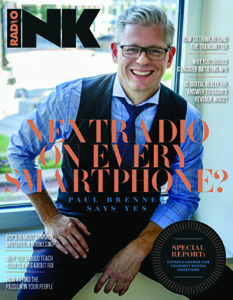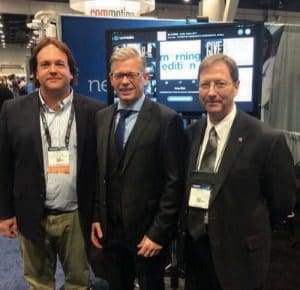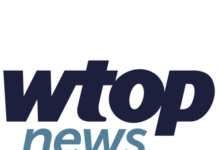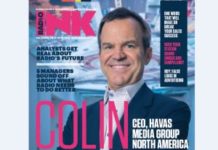
Emmis CEO Jeff Smulyan says that what Paul Brenner has done is remarkable. “After building the Broadcaster Traffic Consortium from the ground up, he assembled the team that has developed NextRadio, and I believe it is radio’s best hope for our future. Paul is not only a brilliant technologist, but a terrific leader and partner who is making a difference in the lives of every broadcaster. I couldn’t be prouder of him.”
As everyone paying attention in radio knows, NextRadio is and has been Jeff Smulyan’s pet project for years. He’s put a lot of time, energy, and money behind the technology that he believes will make radio cool again. He believes NextRadio will lead radio to more revenue, and he believes it will make radio more competitive in a world where the life of every consumer revolves around a smartphone. For years he’s called NextRadio a game-changer. The person charged with making all that happen is Paul Brenner.
Paul Brenner and Jeff Smulyan met back in 1995, when Brenner started working for Smulyan as a consultant. They’ve worked together ever since. Brenner became a full-time employee of Emmis in 1998, doing automation and technology work. “It was a fun company, and it was a fun medium,” he says. “I got drawn to media and entertainment. It was a nice mix of technical challenge and fun. Whenever Jeff wanted to take on some growth opportunities, I was part of the regional group to help him get there, and just bounced around to four different jobs inside the company.” Those four jobs: head of technology and IT, CTO, president of the Broadcaster Traffic Consortium, and, now, president of both BTC and NextRadio.
Both Brenner and Smulyan have done an excellent job of getting many radio companies — and high-level radio executives — on board with NextRadio. They fully support the project, and some groups even run ads to promote it to listeners. Brenner and Smulyan are consistently pushing radio to make stations more interactive on the app, because that’s what consumers want. And they have started working with national advertisers to show them how NextRadio can provide them with the kind of data from radio that other digital outlets have been able produce for years.
The carriers now actively working with or compatible with NextRadio already include Sprint, Boost, Virgin, AT&T, Cricket, T-Mobile, MetroPCS, and US Cellular. Handsets where consumers can find NextRadio include models from Samsung, HTC, LG, Alcatel, Motorola, Huawei, BLU, ZTE, Kyocera, Sharp, and ANS. More announcements are planned after this issue goes to print — and more deals will have to be done if NextRadio really is going to change the game.
So can Paul Brenner get NextRadio on every smartphone in America and transform the radio industry?
Let’s find out.
RI: Let’s rewind on your career a little. The Broadcaster Traffic Consortium: How did that get started?
Brenner: Back in 2006, I put Jeff Smulyan in a room with some other folks. I made an observation about the value of HD Radio to our industry and how data services, and the ability to send not audio, but data and information, over the transmitter was going to be something really valuable. Jeff committed to helping me bring together a group of eight initial broadcast owners and kick the idea around. Those people formed the Broadcaster Traffic Consortium. That was 2007. Now we’re up to 24 broadcast members across the U.S. and Canada.
 RI: What is BTC doing now?
RI: What is BTC doing now?
Brenner: Based on the idea of pooling spectrum across nationwide markets and then taking that pooled spectrum and having a partner willing to use it for content distribution — that’s the company. We built the network and partnered with, at the time, Navteq, which became Nokia, which spun off as HERE. They are the content partner for sending data, like traffic information, weather, fuel prices, to probably about 20 million portable automobile devices in the marketplace.
RI: How many employees are there putting this all together?
Brenner: Here has about 6,000 employees that focus on various things. We have a team of about 150 that are specific to traffic. And within the Broadcaster Traffic Consortium, amongst the contributing members, I would say there’s somewhere between 16 and 20 people that work on it regularly.
RI: What is your role with BTC these days?
Brenner: I run the board and I manage relationships with the broadcasters, but I visit the automakers and talk about the company. In a lot of strange ways, the work with HERE as a content company, the BTC’s development with the automakers, it kind of ties together with NextRadio, because it’s always about radio and its distribution and efficiency as the lead-in. Then radio’s use as a data distributor is one side of the house, and radio’s use as kind of an interactive hybrid radio is the other side of the house. In a strange way, they are very tied together. So I end up in one meeting wearing two hats, quite often.
RI: How competitive is the data-delivery business?
Brenner: The data to the consumer is going to come over a WiFi connection, a 3G or 4G connection, or cellular modem- or satellite radio-connected car. We are winning in the market with the utility of traffic, weather, and fuel, because it’s a lot of overhead, and radio is the most efficient way to cover an entire market with the same content. In that way, it’s a competitive space, but I can tell you we’ve won several automakers over, and there are a couple more we haven’t announced yet. But, on the ground, when you’re doing a ground truth test, as they would say, head-to-head with other forms of distribution, we are winning.
RI: Give us an example of an end product where a consumer would hear data being delivered from your work.
Brenner: Garmin. If you buy a Garmin unit that says “free lifetime traffic,” that lifetime traffic is being sent to that device by HD Radio, and the BTC is the network distributor. That’s one. If you buy a Honda, any Honda that comes with navigation, traffic, weather, and fuel, that comes from the BTC. Mitsubishi is another. Mercedes, Audi. These are all companies that, if they have traffic information being sent to the head unit, it’s being broadcast over the BTC network.
RADIO’S GAME CHANGER
RI: The next big idea was NextRadio. Where did the idea come from? How did it all get started?
Brenner: BTC is a great line of questioning, because NextRadio was really born out of this idea of the power of a unified industry — and, looking back on BTC, what did we do right, what did we do wrong there? And then thinking about FM in the smartphone. We knew the FM smartphone was there; we knew the chip was in the phone, based on some consultant information. It came out of this idea of developing a thing that can be a unified industry effort.
This is a conversation with people inside of Emmis and the NAB, getting this kind of conversation loop going. It resulted in a prototype with handset maker ZTE that was really about activating a tuner, but also presenting something that was very supportive of the industry in total. That was really the goal from the outset, to make something where, yeah, you can turn on the chip, but if you’re going to make a difference for the industry, everyone has an equal footprint in the app, and the content is engaging and gives radio something new to work with as an industry.
RI: What year was all this getting started?
Brenner: Well, we did the cloud part of this, the TagStation that ties the content to the app, that probably all started in about 2008. And then the app itself and the work on the prototype started in 2010. A little bit of strange history: The cloud version, TagStation, the thing that feeds NextRadio the synchronous content for the radio station, it was actually the white-label song tagging for Apple’s iTunes Store.
We wrote that with Apple, with the intention of helping the industry support the FM-enabled iPod. That was Eddy Cue, Tony Fidel; Eddy Cue is a big name there now. He was around the team. We presented that to Steve Jobs.
RI: How did that presentation go, with Jobs?
Brenner: I wasn’t in the room at the time. It was really limited to just Apple people, for the most part. It was one of those early things, that Apple really was very disappointed that the radio industry, in total, didn’t support song tagging for the FM iPod. To this day, it kind of haunts us that we didn’t come through on that. But the platform, we just basically reinvented it and focused on its purpose for connecting to radio stations with serving the NextRadio app, as opposed to the FM-enabled iPod.
RI: Explain song tagging.
Brenner: FM-enabled iPods were something that Apple brought to the market and said that if you were listing to local radio through your iPod, you could press a “Tag” button. And then when you connected your iPod to your computer, the iTunes Store would automatically put those songs you tagged into your shopping cart.
RI: Why did radio decide not to support that?
Brenner: There were a lot of people in the room. There were 25 companies in the discussions out at Cupertino at Apple’s offices, and they asked us to support it, and everybody said they would. But, at the end of the day, only a couple of companies did — a handful, maybe three or four. Apple didn’t really appreciate that. The song tagging and the link-share business just went away.
RI: Do you think, looking back, that was a mistake?
Brenner: Yes.
RI: Why?
Brenner: Because in everything that I work on, whether it is BTC or that opportunity with Apple, an outsider to the industry always has doubts about the radio industry’s ability to unify and to do some type of innovative development that requires everyone to support it and everyone to act in a common way. That holds true with everything that I’ve worked on.
I think Apple was one of those moments where we could’ve all done ourselves a lot of good by doing something all the same and showing a technology giant like Apple that it’s possible. And we didn’t. I think, to this day, that haunts us.
RI: So now it’s 2010. How is the NextRadio project progressing?
Brenner: Any development is a lot slower than people realize. It’s years’ worth of work. Any of these stories that people read about now, where you see explosive growth, there’s years’ worth of development behind them. Our efforts were, 2010 through 2012, to build a back end and to build phones and apps that could be commercialized. Once we got to that point where Sprint was willing to negotiate as the first mover, we were ready for it. We all worked really hard in startup mode for a couple of years, and when the moment came, we were ready for it.
RI: Did you have a lot of industry support early on? 
Brenner: We had NAB support, which was extremely helpful. At the time, that was FastRoads, which is now called NAB Labs. We had their support. We had your traditional friendly CEOs who are trying to make a difference, [Hubbard CEO] Ginny Morris, [Entercom CEO] David Field, [Greater Media CEO] Peter Smyth, [Radio One CEO] Alfred Liggins, [Beasley CFO] Caroline Beasley, people that are putting it out there and want to be part of something interesting. And that was strong, from the very beginning. Those folks were there, helping with lots of things.
RI: Take us behind the scenes where the team from NextRadio and TagStation work. How big is the team? And what are they working on every day?
Brenner: Remember, we owned Emmis Interactive. That was the company we had, which was up to 40 or 50 employees. Marketron bought the content-management system assets. I retained a group of about eight people from that divestiture, the folks that had been working with me on NextRadio and TagStation. They were very knowledgeable. So, when we started, it was about two or three people here in Indianapolis and about eight in Chicago.
We are now up to about 18 in Indy and 18 in Chicago, and a couple spread around the U.S. that are job-focused. We have somebody that reps wireless partnerships in another part of the country. There are a few people like that around the United States and Latin America. So we are probably up to now, either full-time or committed contractors, around 40 people.
What are they doing every day? They’re working with the broadcasters. They’re connecting systems to the network. They’re writing software, whether that’s TagStation and getting better at that, or always making NextRadio better. They’re always doing those things.
You want some behind-the-scenes? If you look at what we have accomplished, most people would say it’s probably a five- to six-year effort. But we’ve done it in three years. That was to get handset makers to add hardware capability, enabling the activation of FM hardware, and letting us control that hardware.
I have a team where all they do is try to make an app better, and for every change they make, they have to regression-test a hundred phones, to make sure it works. We are not just an app you pull out of the Play Store. There’s a hardware dependency. I don’t think the industry realizes just how much time and energy goes into making sure that every consumer with a compatible phone, when they use it, it’s great. That’s a lot of work.
RI: Where does the funding come from to keep all this going, paying the people and running the operation?
Brenner: Emmis, primarily through other operations. We’ve received a little bit of money from NAB over the years, a small investment that was earlier money. More recently, Emmis and Jeff have been recognizing this is good for the industry and will continue to support it. And then the Sprint money, of course, is not really an investment in Emmis. It’s essentially wire transfers — everything that inflows from the broadcast contributors goes right back out to Sprint, relative to that payment. But that’s 100-plus companies, and hundreds more medium to small broadcasters through barter, all helping pay that Sprint payment.
RI: And do you get some revenue from stations that buy more than the basic TagStation package?
Brenner: TagStation licensing is a loss leader; we don’t even charge people enough to cover the expenses of running TagStation as a hard cost. Where we expect it to be helpful, for example, is with a paying advertiser — and we have a couple now — they’re paying for enhanced campaigns and data reports, and the majority of the proceeds go to the broadcasters who participated. And then a large balance goes to the carrier. And Emmis gets a piece of that. That’s what Jeff wants to see, the broadcaster getting the biggest upside, and Emmis uses a portion of that to cover their investment.
RI: Talk about one of the promotions that was a success. What are things going to look like when it’s all at full speed?
Brenner: Aloft Hotels has been a really nice one. That Allstate test has been interesting. Jeff has alluded to the Home Depot test that’s been going on. We’ve done some work with Disney around Demi Lovato and promotional testing. Across all of those, what’s consistently demonstrating its effect is that regardless of an advertiser or a label or a promoter, they’re seeing really high engagement rates — so the number of people that are listening to FM smartphones have a 100 times higher engagement rate than digital ads through other mediums.
More importantly, we can tell them about their audience. We can say, “Here are the people that heard your ad or saw your promotion, and here’s their profile. Here’s the action that they took.” And that’s where you get that true benefit of marrying FM live broadcast inside of a capable device like a smartphone, where I can learn an awful lot about that listener and then package that up as information that goes to the advertiser or the label to learn something. That’s the excitement.
RI: Is it frustrating at all when the majority of the industry is gung-ho about NextRadio but radio’s biggest company, iHeartMedia, has its own, heavily promoted app?
Brenner: I think at a philosophical level, iHeartRadio is a streaming app. That’s a different form of distribution — a small percentage or even a negative performer relative to the revenue of the company or the industry. Versus what we’re doing, which is really hard-and-fast committed to being an FM broadcast app.
In that perspective, that’s a little frustrating because I think sometimes it’s viewed as competitive when it’s really two completely different forms of how to reach the audience. It’s frustrating now, in the market. There are definitely advertisers and buyers and labels and other people that kind of tie themselves to radio; they see the conflict. It’s often brought to my attention with, “How are you going to solve this?” They ask me to answer that question. I often don’t know how to answer that question.
IHeart, they’ve been supportive in a lot of those areas. Their content is connected within the app. Their stations are interactive when it comes to the music and the noncommercial content. But there’s other aspects where it could have a lot more benefit to the industry if literally everyone was participating equally.
RI: What do you want the local stations to know about how this app will help them generate more revenue?
Brenner: At the scale we’re at now, national is where we’re starting with the revenue. Over time, as we grow more and more users, it becomes medium-market and smaller-market. What we’re seeing — and what radio broadcasters should be excited about — is that the world has become a place with expectations of measurement that goes beyond what radio currently offers.
When you look at the Facebooks and the Googles, who between them are getting 47 percent of the total global ad market and 85 cents on the dollar of mobile ad spending, they’re doing that because of, for one, scale for sure, but, two, their ability to show the specific audience performance. When we go into advertising agencies now, in one hour, you would probably hear three, “Wows,” or, “That is unbelievable,” or, “I need this.” Complete and pure excitement about the ability to show the performance of their ad dollar on radio.
That’s what a radio station should be excited about, because this is about saying, “Yes, we have reach. We are 93 percent of the American audience.” We can keep those stats flowing all day long. Now, through the measurement of the smartphone listener, I can show you more about your audience than you’ve ever seen before. That’s how you make money off of this.
RI: When do you think it will be that, every time a consumer walks into a store, whatever phone they buy will be preloaded with the NextRadio app?
Brenner: I think by the end of 2017, just about every Android model that’s sold will be NextRadio-capable. Whether they’re preloads or not is hard to say, because the preload market is changing. It’s not a market that’s easy to sustain. You’ve got a bring-your-own-device world evolving, which is kind of the unlocked-smartphone world. That’s going to be a big growth in 2017.
What we’re trying to do is make sure that all the folks that are either building the phones or ordering the phones are building the FM capability and then NextRadio compatibility into that phone. If all Android phones are sold FM-capable, if we had 25-30 percent as preloads and the rest requiring users to download it — I think that’s where we will probably end up.
RI: You are probably tired of hearing this question, and perhaps what you told us earlier has something to do with why. Is Apple ever going to be on board?
Brenner: Apple’s strategy is to use Beats 1 as a way to re-create local radio on a streaming platform. Eddy Cue just made that comment recently; that’s their strategy. Wired magazine even called them out and said Apple is unlikely to do something like FM radio that goes against their Beats 1 strategy. If you look at it on the surface, that’s probably where they’ll stay for a while.
If the radio industry, just like we should’ve done before with Apple, can come to a point where everybody’s on board equally and making the same amount of effort to show Android users something completely new, and advertisers and record labels something completely innovative, Apple will pay attention. I worked around them long enough to know that they do pay attention. So I think if the industry comes through at that level, Apple has got a good chance.
 RI: Is the radio industry doing enough to promote NextRadio?
RI: Is the radio industry doing enough to promote NextRadio?
Brenner: We have a lot of companies that have committed a lot of promotional inventory for NextRadio spots. I think we should all thank them for that — and there are many of those, hundreds of companies and thousands of stations across the country. The biggest company is not supporting that, as a conflict of interest.
But I think beyond that, where radio could really help, is that the power of radio is localism. Where we are not following that through is the voice in the community — the local jocks, the DJs, the messaging in the opportunities when their most engaged listeners are taking their advice. That’s where we need to do a better job, I think, of getting it down to that level and asking the stations to do something a little more creative.
RI: Jeff Smulyan has often said that NextRadio is a game-changer for the radio industry. I’m guessing you agree with that.
Brenner: Look, I support Jeff. I agree with that. I think we started in a place where he tasked me and others with getting FM turned on and addressing portability and the perception of radio being only in the car. That’s kind of where we started, and we’ll continue to grow that.
But if I took you with me out on a road trip to meet some of the biggest brands or agencies or record labels and you sat with me through this presentation that says, “Yes, thank you for buying radio and thank you for putting your content on broadcast radio. Let me give you a little snapshot of exactly who heard your commercial or your song, what they felt about it, and what they did to take action. Did they go to your store? Did they book your hotel? Did they attend your concert?” The look on their faces, if it doesn’t describe game-changing, then I am not sure what does.
RI: What are you most excited about heading into 2017?
Brenner: We’ve got the interest of all the right parties. We are scaling the number of people who listen. This story is going to shift, and you’re going to hear more about the ability to measure the listener and give that direct feedback. I think that’s when everybody is going to pay attention. That’s when broadcasters are going to see ROI. Advertising agencies are going to be calling us looking for, as an industry, how they can leverage this platform. We’re pushing the cart. I think, 2017, we are getting drug behind a runaway horse.
RI: If there was one thing that you wish you could have right away when it comes to the success of NextRadio, what would it be?
Brenner: Everybody involved. Again, I go back to that point of my lesson with Apple. And I see it with BTC and the automakers. The number one question is, “Can the radio industry come through?” I think anybody reading this should be asking themselves, “Are we doing what we can? With content, with helping drive downloads, with creating this space that is going to benefit all of us?” That would be my dream, that everybody just feels like it’s natural for them to be doing everything they can to help.
RI: What excites you about walking into work every day?
Brenner: I’m the guy that loves change. Calculated change. I get excited because all of the people I work with love radio and love fun, innovative products and positive, exciting people. That’s my motivation: that we all feel like we know why we do what we do. We love radio. We love the public service aspect of radio. We love broadcasters. But we also get to play in this sandbox that is just some of the coolest toys and technology that you can think of.
RI: Anything else you want the industry to know about you or NextRadio?
Brenner: I’m a passionate guy, and I like to do big things. I love my team, and I love what they do for me. I continue to be hopeful that all of this is going somewhere and that everybody jumps in and makes it come to life.








